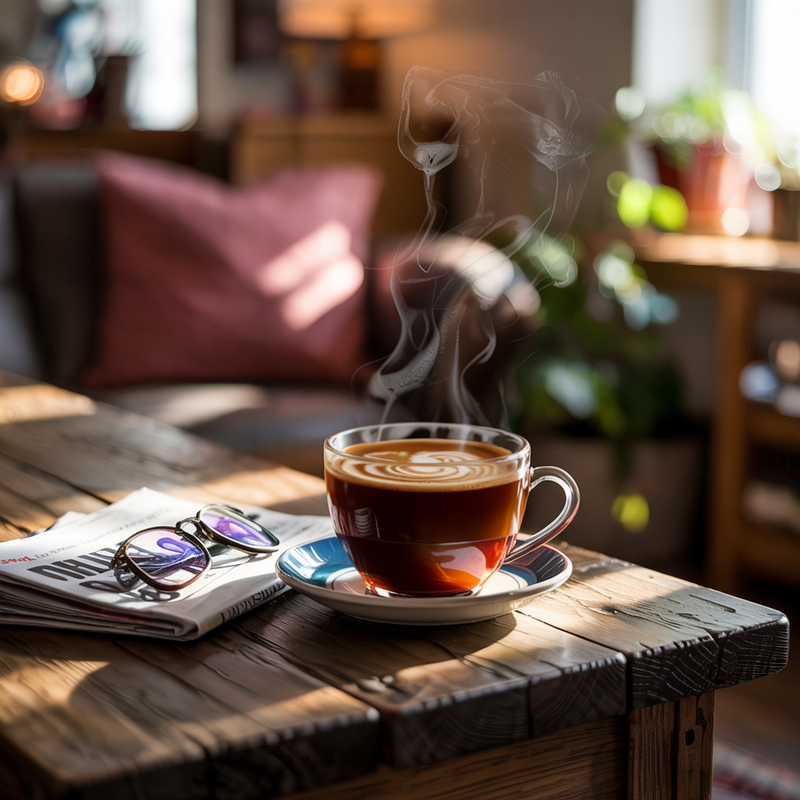What if we told you that most commercial coffee contains invisible toxins that can mess with your energy, gut, and brain?
Today we're pouring out some truth about mycotoxins, how they sneak into coffee, and why Giddy Yo Clean Coffee should be your choice for a healthy cuppa joe!
Is Your Coffee Making You Sick—or Helping You Thrive?

Conventional coffee, which is grown in hot humid environments, is one of the most chemically treated crops in the world—and poorly processed and stored coffee beans are especially prone to mold.
This mold produces mycotoxins, and when ingested via your coffee (and other foods), can have a neurotoxic, nephrotoxic, and hepatotoxic effect causing fatigue, brain fog, inflammation, kidney and liver damage, immune suppression and more.
“Up to 91% of green coffee beans may contain mold toxins if not properly processed or stored.”
— FAO/WHO Food Safety Report
The good news: when your beans are clean, consciously sourced, and 3rd-party lab tested (like ours), you'll notice:
Happy digestion
No jitters or anxiety
Focus without fog
- Ochratoxin A (OTA): Roasting reduces OTA levels by 20–90%, depending on temperature, duration, and bean type. Darker roasts (higher temperatures, longer times) degrade OTA more effectively, but complete elimination is unlikely.
- Aflatoxins: Aflatoxins are highly heat-stable. Studies show minimal reduction (0–50%) during roasting, with darker roasts having slightly better degradation.
The key to sourcing clean beans is to ensure the beans never get moldy in the first place… read on for how Giddy Yo accomplishes this!
From Crop to Cup: The Giddy Yo Mold-Free Process
Here's how we ensure every bean you brew is as clean as it is delicious:
- High-altitude, organic growing conditions: naturally reduce mold risk.
- Fresh hand-picking: only ripe, fresh undamaged and unmoldy cherries are chosen. Industrial scale farms use machines that shake the bushes collecting ripe, unripe and moldy cherries. The smallest amount of mold will invariably infect a very large batch. Imagine what happens when one moldy strawberry is placed in a vat of strawberries- 24 hours later that one strawberry has created a moldy mess.
- Depulping and Fermentation: The ripe red cherries are put into a hand operated depulping machine which removes the skin only, leaving the pulp attached to the two rock hard green beans, followed by a 12-24 hour fermentation.
- Washing: Following fermentation, parchment lined beans are washed in clean water and dried on elevated platforms.
- Careful drying: Beans are dried slowly under the sun on elevated platforms to a moisture content of about 10-12%. Mold thrives in improperly dried beans so the beans are monitored closely.
- Hulling: The beans, still encased in its parchment (a tough, papery endocarp), are fed into a hulling machine which uses friction and mechanical action to strip away this layer revealing the green coffee bean inside. The chaff, a thinner delicate membrane, remains on the green bean even after hulling, and will be removed during the air roasting.
- Storage in proper climate-controlled environments: This prevents mold growth during transit and is an essential step as even the most perfectly processed quality bean can be ruined if not stored properly.
- Air Roasting: The hot air stream removes chaff during air roasting, collecting it in a separate chamber. This prevents chaff from burning and imparting bitter or smoky flavours, which can happen in drum roasting if not properly managed. Contaminants could be found on the chaff, so removal is important step.
- 3rd-party lab testing: Once our beans arrive, we immediately send to the lab for testing for mycotoxins (ochratoxin, aflatoxins), as well as microbial contamination (yeast, mould, eColi, etc.) — so you can sip stress-free.
Sad Fact: Commercial coffee producers do things differently, all in the name of profits. In additon, there are certain 'freshening' and 'flavour enhancing techniques' these, let's call them 'drive-thru' coffee companies, partake in… buyer beware!

If you're drinking coffee every day (and let's be real, you probably are), make it a brew that fuels your body—not compromises it.
- Light Roast – full of freshy citrus and vanilla notes
- Medium Roast – balanced, classic, and oh-so smooth
- Dark Roast – bold, rich, satisfying
- Decaf – clean, decaffeinated using a chemical-free Mountain Water Process (our decaf is currently NOT certified organic)
Clean Colombian Coffee Beans, Clean Planet
Giddy Yo proudly sources our coffee from Colombia, the country most synonymous with coffee production. Colombia is famous for good reason: they make excellent coffee! Giddy Yo light, medium and dark roast beans originate from a co-op made up of 80% women heads of family, 20% young people, of which 100% are victims of the armed conflict in Colombia. The beans are grown at an elevation of 1500-1900m, and consist of the Castillo and Caturra varietal. To boot, our light/medium/dark roast beans are certified organic and Fairtrade.
Clean coffee = good for your health and the environment.
Moldy Coffee? Not on Our Watch
- Organic, Fairly Traded and Ethically Sourced
- 3rd-Party Tested for Mycotoxins, Mold and other contaminants
- Small-Batch Air Roasted for Freshness
- Naturally Low-Acid & Smooth
- It's so good our customers tell us they 'can actually drink their coffee black' - we hear this a lot
- Those who have not been able to drink coffee due to gut upset share that they can FINALLY enjoy Giddy Yo coffee!
- Won't produce coffee 'dragon' breath
- Bye bye coffee-induced jitters or feelings of anxiety
Bonus: Pairs beautifully with our allergen-free dark chocolate.
SHOP Giddy Yo CLEAN COFFEE NOW
REAL TALK FROM THE GIDDY GANG
— Giddy Yo Customer



